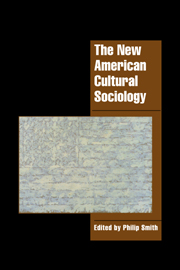Book contents
- Frontmatter
- Contents
- Notes on contributors
- Preface
- The new American cultural sociology: an introduction
- PART I Culture as text and code
- PART II The production and reception of culture
- PART III Culture in action
- 11 Culture and social action
- 12 Culture, structure, agency, and transformation
- 13 Discourse, nuclear power, and collective action
- 14 Moral boundaries, leisure activities, and justifying fun
- 15 Honor and conflict management in corporate life
- 16 The role of cultural capital in school success
- Index
- Title in this Series
13 - Discourse, nuclear power, and collective action
Published online by Cambridge University Press: 18 January 2010
- Frontmatter
- Contents
- Notes on contributors
- Preface
- The new American cultural sociology: an introduction
- PART I Culture as text and code
- PART II The production and reception of culture
- PART III Culture in action
- 11 Culture and social action
- 12 Culture, structure, agency, and transformation
- 13 Discourse, nuclear power, and collective action
- 14 Moral boundaries, leisure activities, and justifying fun
- 15 Honor and conflict management in corporate life
- 16 The role of cultural capital in school success
- Index
- Title in this Series
Summary
Introduction
Sustained collective action involves a symbolic struggle. In the broadest sense, it is a struggle over the legitimacy of a regime and trust in the incumbent political authorities. Every regime has a legitimating frame that provides the citizenry with a reason to be quiescent. It is a constant, uphill struggle for those who would sustain collective action in the face of official myths and metaphors.
At a more contextual level, collective action focuses on particular historical conditions and policies. It has a substantive content. It takes place in some issue arena, however broadly or narrowly defined. People act on the basis of some meaning system, and the definition of issues, actors, and events is a matter of constant contention. A central part of the symbolic struggle, then, is about the process of constructing specific meanings.
As theories about ideological hegemony and false consciousness have emphasized, challengers face a formidable task. But the difficulty varies over time for all challengers and, at any single moment, among them. For some, the official meanings with which they must contend are deeply embedded and well-defended; for others, official meanings are in crisis and disarray or perhaps even discredited. Such moments offer opportunities for challengers that may not last.
Mobilization potential has, then, a strong cultural component. To understand it, we need to assess not only structural conduciveness but also cultural conduciveness. Not all symbols are equally potent. Certain packages have a natural advantage because their ideas and language resonate with larger cultural themes. Resonances increase the appeal of a package; they make it appear natural and familiar.
- Type
- Chapter
- Information
- The New American Cultural Sociology , pp. 202 - 216Publisher: Cambridge University PressPrint publication year: 1998
- 11
- Cited by

